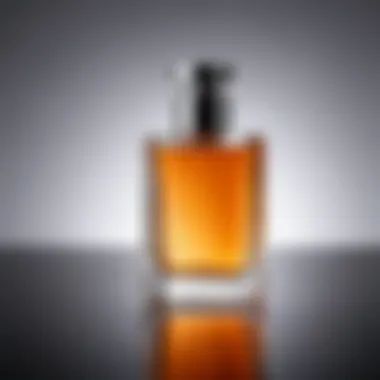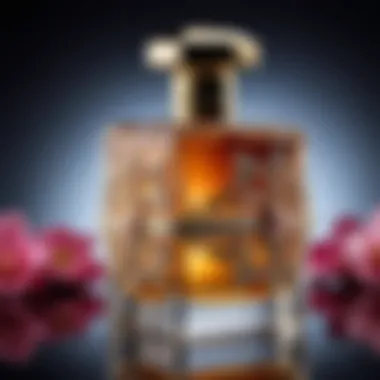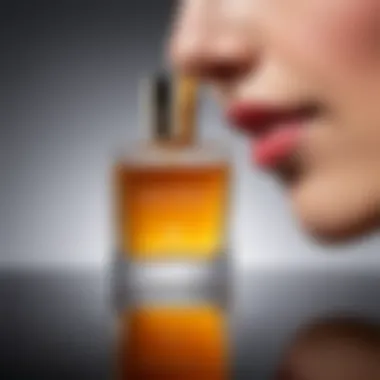Cologne vs. Perfume: Key Differences Explained


Intro
Fragrance has long been a sensorial companion in our daily lives, sometimes just a pleasant aroma and at times a powerful statement of identity. Within this world of scents, two familiar terms frequently pop up: cologne and perfume. However, these words often confuse consumers, leading many to overlook their distinct attributes. When folks stroll through fragrance counters or scroll through online selections, they generally find themselves pondering if they should reach for that bottle of cologne or opt for a more intense perfume. Understanding the nuances can not only save time but also enhance the overall experience of choosing a fragrance.
Cologne and perfume are not one and the same, and making the right choice heavily depends on a variety of factors. From the concentration of fragrance oils to intended occasions, each offers unique characteristics that can significantly impact your experience and the impression you leave on others.
In this article, we examine the differences between cologne and perfume, aiming to equip you with the necessary knowledge to select the ideal scent. Diving into composition, longevity, and appropriate settings, we will disentangle common myths and provide practical tips for navigating the budding world of fragrances. Let's embark on this aromatic journey together.
Prolusion to Fragrance Types
Fragrance, an often underestimated aspect of our everyday lives, holds a transformative power. When we talk about cologne and perfume, we navigate through an intriguing universe where each scent embodies emotions, memories, and cultural stories, intertwining with personal identity and societal interactions. Understanding these distinctions isn't just about choosing a scent—it's an exploration of our preferences, habits, and experiences.
The significance of fragrance types extends far beyond the olfactory experience they provide. They serve as social signals, shaping our interactions and how we want others to perceive us. Imagine walking into a room, and the soft whisper of your fragrance lingers behind you, leaving an indelible impression on those present. Choosing between cologne and perfume then becomes not merely a matter of personal taste; it’s an expression of who you are and how you wish to communicate your essence to the world.
The Essence of Fragrance
The term "essence" when it comes to fragrances is rich with implication. At its core, essence refers to the raw ingredients that culminate into a scent. The artistry of fragrance creation combines various notes: top, middle (or heart), and base notes. These notes form a pyramid of aroma that evolves over time, showcasing how scents can change from the moment they are applied.
For instance, the bright initial zesty lemon or bergamot might greet you right after application, but what follows is a deeper heart of jasmine or lavender, and finally, a warm cedarwood or vanilla that lingers long after. This gradual evolution is akin to telling a story where every note is a chapter—each uniquely contributing to the overall narrative that the fragrance portrays.
Cultural Significance of Scents
Scents are deeply woven into the fabric of society across civilizations. Historically, fragrances have played roles in rituals, celebrations, and even day-to-day activities. Across cultures, scent has been linked to notions of purity, healing, and even empowerment. For instance, in ancient Egypt, it was common to use fragrant oils and resins during mummification, believed to assist in the afterlife journey.
In many Asian cultures, scent is integral to spiritual practices, often used in temples or during meditation to create an atmosphere conducive to mindfulness. The use of incense, infused with aromatic oils, enhances the experience, facilitating deeper connections to the divine.
"The right fragrance can evoke nostalgia, creating memories that linger far beyond the moment."
Today, fragrance continues to serve various purposes beyond mere enhancement of personal hygiene. In Western societies, the choice between using cologne or perfume often reflects social status, preference, and even personality traits. While exploring fragrance types, one may also consider how personal choices can reflect broader cultural trends, consumer behaviors, and market dynamics.
In this journey through the delightful complexities of scents, understanding the nuances between cologne and perfume emerges as pivotal. It’s not just about the fragrances themselves but how they resonate within us and reflect the world around.
What is Cologne?
Cologne is more than just a splash of fragrance; it embodies a rich narrative of history, artistry, and personal expression. Understanding what cologne is essential in unraveling the broader differences between cologne and perfume. This section will delve into its historical roots, its intricate composition, and the nuances of its concentration, providing a holistic view that caters to both fragrance novices and enthusiasts. By appreciating these elements, individuals can better navigate their choices in the scent world.
Historical Background of Cologne
The origins of cologne trace back to the early 18th century in Germany. The story begins not far from the banks of the River Rhine, where Giovanni Maria Farina first crafted his fragrant water. He aimed to encapsulate the fresh scent of springtime in Italy. His creation came to be known as "Eau de Cologne," and it quickly gained popularity among noble figures across Europe.
Over the decades, cologne's reputation spread like wildfire. It became a staple in royal courts, often given as a gift or used to signify wealth and sophistication. To this day, the region of Cologne, Germany, continues to be a pivotal location in fragrance production, with a multitude of houses contributing to the legacy started centuries ago. This rich history adds depth to every bottle of cologne, reminding users of its timeless allure and how it has transformed over the years.
Composition of Cologne
The composition of cologne is what sets it apart from other fragrance types. Traditionally, cologne consists of a mixture of essential oils, alcohol, and water, usually containing about 2-5% fragrance oil. This lighter formulation gives cologne its characteristic refreshing quality. Unlike perfume, which is typically heavier and more concentrated, cologne prioritizes a lighter, more fleeting experience.
To break it down further, the structure of cologne can be categorized into three fragrance notes:
- Top Notes: These are the initial scents one experiences upon applying cologne. Often citrusy or herbal, they set the stage for the fragrance's evolution. Think lemon or bergamot.
- Middle Notes: Also known as heart notes, they emerge after the top notes fade. This is where floral or fruity scents often come to play, providing depth.
- Base Notes: These develop last and linger the longest, often featuring warm, rich notes like musk or cedarwood, offering a satisfying closure to the fragrance experience.


Cologne Concentration Explained
When it comes to cologne concentration, it's vital to grasp how it relates to scent longevity and overall fragrance experience. As mentioned earlier, cologne contains around 2-5% fragrance oils. This relatively low concentration makes it a perfect choice for those who prefer a more subtle aroma.
The implications of this concentration are significant:
- Longevity: The scent typically lasts for a shorter duration, often around three to four hours, making cologne ideal for casual wear or daytime events.
- Intensity: With a lighter formulation, cologne can be reapplied throughout the day, allowing for varied olfactory experiences without overwhelming the senses.
- Versatility: Cologne’s refreshing nature makes it suitable for a wide range of settings, from the office to leisure activities.
Ultimately, understanding these details helps individuals make informed decisions about when and where to wear cologne, fitting it neatly into their lifestyle. By recognizing its historical roots, its crisp formulation, and the practical aspects of concentration, one can better appreciate what cologne brings to the table in the world of fragrance.
What is Perfume?
Perfume is not just a fragrant concoction; it embodies emotion, memory, and personal expression. Understanding perfume helps one appreciate why certain scents resonate differently based on personal preferences or cultural contexts. It acts as an invisible accessory, enhancing one's presence while often leaving a lasting impression, echoing long after one has left the room. It plays a pivotal role in a person's identity and can even influence mood and confidence.
Historical Evolution of Perfume
The history of perfume stretches back millennia, with traces found in ancient civilizations. The Egyptians were masters of scent, using incense and oils in religious ceremonies and as part of their burial practices. They believed that scents affected the journey to the afterlife. Fast forward to Ancient Greece, where perfume became more personal, symbolizing wealth and social status. The Greeks would blend floral extracts with oils, sparking the evolution toward modern perfumery. In fact, Aristotle once remarked on the power of perfume, reflecting its deep-rooted significance in human culture.
Scroll to the Middle Ages, and perfume took on new dimensions as it was used more extensively in Europe, with monks crafting scents in monasteries. The Renaissance brought a flourishing of fragrance, with innovations and trade expanding the availability of exotic ingredients. By the late 18th century, the perfume industry as we know it began to take shape, thanks largely to advances in chemistry.
Composition of Perfume
Perfume is made up of several key components that work together to craft its distinctive scent. At its heart, fragrance oils constitute the essential elements that define a perfume's character. These oils are derived from both natural and synthetic sources. The composition usually falls into three notes:
- Top Notes: These are the initial scents perceived immediately upon application, often fresh and light, like citrus or herbs. They typically evaporate quickly, lasting only a few minutes.
- Middle Notes: Also known as heart notes, these emerge once the top notes fade and provide the perfume's core essence. They tend to be more rounded and fuller, often featuring floral or spicy elements.
- Base Notes: These form the foundation of the fragrance and linger much longer. Deep and rich scents, such as woods, amber, or vanilla, create lasting impressions.
Each element contributes to the overall experience of the perfume, making its composition an art form as much as a science. The innovative blend of notes is what distinguishes one scent from another, crafting unique olfactory experiences.
Perfume Concentration Explained
When it comes to perfumes, concentration matters immensely. It refers to the percentage of fragrance oils in the product, which directly affects its scent potency and lasting power. There are generally a few categories of perfume concentration:
- Parfum (Extrait de Parfum): This has the highest concentration of fragrance oils, usually between 20% to 30%, providing intense scent longevity - often lasting a full day or more.
- Eau de Parfum (EDP): With a concentration between 15% and 20%, EDP offers a balanced fragrance that lasts a significant time yet is less intense than parfum.
- Eau de Toilette (EDT): Typically containing 5% to 15% fragrance oils, EDT tends to be lighter and more suitable for casual wear, often needing reapplication after several hours.
- Eau de Cologne (EDC): Comprising around 2% to 4% oils, EDC is the lightest and most refreshing, ideal for those who prefer a subtle scent.
Understanding these concentrations helps consumers make informed decisions. Ultimately, choosing the right concentration can elevate one’s fragrance experience based on occasion and personal preference.
Comparative Analysis of Cologne and Perfume
The exploration of cologne and perfume is not just about identifying scents; it's a deeper look into how these fragrances intertwine with our lives and self-expression. By breaking down the components that differentiate cologne from its more concentrated counterpart, perfume, we can gain insight into their unique roles and offerings. This comparative analysis lays the groundwork for choosing the right fragrance based on specific needs such as occasion, mood, and personal preference.
Fragrance Longevity and Intensity
When assessing fragrance longevity and intensity, one can't overlook the concentration levels that define cologne and perfume. Generally, perfume contains a higher concentration of essential oils—typically between 20% to 30%—which results in a scent that lasts longer and often develops into more complex layers over time. In contrast, cologne typically consists of about 2% to 5% essential oils, leading to a lighter fragrance that may require touch-ups throughout the day.
For individuals who prefer a subtle hint of scent, cologne offers a refreshing choice, easily applied for a quick boost. On the flip side, those who want a long-lasting signature scent may find perfume more appealing.
- Cologne: Usually light, refreshing, and ephemeral, perfect for daytime wear.
- Perfume: Rich, deep, and longer-lasting, suitable for evening occasions or special events.
This distinction not only shapes personal preferences but also indicates the intended use of each fragrance type in day-to-day life.


Scent Profiles and Characteristics
Diving into the scent profiles, the differences between cologne and perfume can be quite pronounced. Cologne often leans toward fresher, more citrusy notes, making it popular for casual wear. Think of zesty lemon, refreshing mint, and bright bergamot combined to create an invigorating aroma that's uplifting.
Perfume, however, usually features deeper and more complex notes. You'll find nuances of jasmine, sandalwood, and even rich vanilla, which contribute to a scent that evolves beautifully over time. Such fragrances tend to invite a more emotional response and can align closely with one’s personality and mood.
Notable characteristics include:
- Cologne:
- Perfume:
- Typically fresh and lively.
- Appeals to a wider audience due to its versatility.
- Often marketed towards younger consumers.
- More intense and sensual.
- Often considered a luxury choice
- Suitable for making a statement or leaving an impression.
This differentiation helps individuals choose what fits them best, based on the occasion and the impression they aim to convey.
Price Differences and Market Trends
Financially speaking, perfume generally carries a heftier price tag than cologne. The higher concentration of essential oils and the luxurious branding often associated with perfumes can influence market pricing significantly.
However, this doesn't necessarily mean cologne lacks value. Its affordability allows for greater experimentation, catering to those who enjoy having multiple options to suit various occasions. Users often find they can buy cologne in bulk or try different fragrances without breaking the bank.
Recent trends show a shift toward unisex fragrances, influencing both cologne and perfume markets. As modern consumers become more explorative, they are more inclined to break gender norms within scent profiles, often leading to a blurring of lines between traditionally defined categories.
- Cologne:
- Perfume:
- Typically more budget-friendly.
- Larger volume options available.
- Increasing appeal in unisex and niche categories.
- Higher price point due to costlier ingredients.
- Smaller bottle sizes tend to be standard.
- Premium brands are increasingly aligning with social causes, gaining market attention.
In summary, while price does play a part, it’s important to remember that value can be subjective and based on one’s individual needs and lifestyle preferences. In turn, understanding these differences will empower consumers to navigate the fragrance world more effectively.
Choosing Between Cologne and Perfume
Choosing the right fragrance is akin to picking an outfit for the day; it often reflects one’s mood, personality, and the events that lie ahead. This section dives into why selecting between cologne and perfume is so significant in our daily lives. From the moment we spritz on that delightful aroma, we’re not just applying a scent but making a statement about ourselves. Factors such as composition, the intensity of fragrance, and personal preference play crucial roles in this choice.
Consideration of occasion is also paramount. A favorite scent might evoke images of romantic evenings or professional gatherings, yet it’s how that scent interacts with the environment that can elevate or diminish its charm. Hence, understanding when and where to wear each type of fragrance enhances not only personal enjoyment but also factors into social interactions—there’s nothing worse than overwhelming those around you with too strong of a scent.
"Fragrances are like a language, and knowing how to speak it can create connections that words sometimes cannot."
Ultimately, the choice between cologne and perfume is a reflection of individual preferences and specific situations. By recognizing the essential differences and making informed selections, one can step out confidently into any arena, much like donning a well-tailored suit or an elegant dress.
Personal Preferences in Fragrance Selection
When it comes to selecting a fragrance, personal preferences hold the reins. Both cologne and perfume have diverse scent profiles ranging from floral to woody to musky. What appeals to one person may be entirely uninviting to another. Understanding your own likes and dislikes is the cornerstone of finding the right fragrance.
A few pivotal questions can guide this process:
- What scents evoke positive memories? (e.g., a mother's embrace or a summer afternoon)
- Do you prefer light and fresh options or deep and intense aromas?
- How do you want to be perceived by others—inviting, bold, or understated?


Often, the scents we appreciate personally can vary based on the seasons. For instance, floral fragrances may be more attractive in spring, while deep, spiced notes may pull you in during winter months. Always take time during your fragrance hunt to test scents on your skin, as the natural oils can alter how a fragrance smells.
Occasion-Based Fragrance Recommendations
When considering a fragrance, context matters far more than most realize. Selecting the right scent for the appropriate occasion can express your style and enhance your experience. Recognizing when to sport cologne versus perfume can set the tone for gatherings and events.
Here are some occasions to consider:
- Casual Day Out: A light cologne—think citrus or aquatic notes—can be invigorating while still being subtle.
- Business Meetings: Opt for a perfume that’s not overpowering, but still has a presence. A fresh, woody scent can be confident yet comforting.
- Romantic Dinners: Go for deeper, more alluring fragrances; think about heavier florals or oaky notes that can heighten the mood.
- Evening Events: Here, the sky's the limit. Full-bodied perfumes can come into play, making sure you leave a lasting impression.
- Outdoor Activities: A refreshing cologne can be key here; look for something airy that won’t clash with your environment.
In summary, understanding the nuanced selections between cologne and perfume not only reflects personal style but enhances social interactions patently. The art of fragrance—both cologne and perfume—invites us to express who we are, adapting our selections based on our values, experiences, and the contexts of our lives.
Storing and Caring for Fragrances
When it comes to fragrances, many folks might not give much thought to how they're stored or cared for. However, understanding proper storage and maintenance of cologne and perfume can significantly impact their longevity and effectiveness. Just as you wouldn’t leave your favorite wine out in the sun, keeping your scents in optimal conditions ensures that they don’t lose their charm or become stale over time.
Optimal Storage Conditions
To keep your fragrances fresh and vibrant, it’s key to store them in the right environment. Here are some guidelines to follow:
- Cool and Dark Places: A cool spot, away from direct sunlight, helps protect the delicate balance of essential oils. Sunlight can degrade the quality and change the fragrance’s character.
- Stable Temperature: Fragrance bottles like consistency, so avoid storing them in places that undergo rapid temperature changes, such as bathrooms.
- Original Packaging: Keeping the fragrance in its original box offers an extra layer of protection from light, dust, and temperature fluctuations.
- Upright Position: Store bottles upright to prevent any leakage and maintain the integrity of the stopper, which can degrade if exposed to liquid over time.
By adhering to these simple recommendations, you can prolong the life and enjoyment of your beloved scents.
Maintaining Fragrance Integrity
Maintaining the quality of cologne and perfume goes beyond just storage. Here are some tips on how to keep those scents as fresh as a daisy:
- Avoid Frequent Air Exposure: Each time the bottle is opened, air seeps in, and this can lead to oxidation. If you have a larger bottle, consider decanting a smaller amount for regular use.
- Keep Away from Heat Sources: Heat can alter the chemical composition of a fragrance, leading to unexpected changes in scent. So, avoid placing them near radiators or other heat-emitting devices.
- Regular Checks: Take a moment now and then to inspect your fragrances. If you notice any changes in color or scent, it might be a sign that they need replacement or special care.
- Use Proper Application: When applying cologne or perfume, avoid rubbing your wrists together. This technique can lead to the breaking down of the chemical structure, ultimately affecting the fragrance.
"Take the time to care for your fragrances, and they will reward you with lasting scent experiences."
Ultimately, the effort put into storing and maintaining cologne and perfume pays off, ensuring every spritz feels just as delightful as the first one. The right care can make all the difference between a fragrance that shines and one that fades into the background.
Culmination: The Art of Fragrance Selection
Navigating the world of fragrances can feel like a labyrinth. In this article, we have examined the essential differences between cologne and perfume, looking at their compositions, concentrations, and characteristics. The art of fragrance selection hinges on understanding these subtleties. Selecting the right fragrance is not a mere matter of personal taste; it requires awareness of factors such as longevity, occasion, and even the environmental context you're in.
When considering whether to choose cologne or perfume, evaluating your lifestyle and scent preferences plays a vital role. For example, colognes are typically fresher and lighter, making them well-suited for daytime wear or warmer weather. On the other hand, perfumes offer deeper, more complex fragrances often intended for evening outings and special occasions.
Recap of Key Differences
To summarize, here are the standout differences between cologne and perfume:
- Concentration Levels: Perfume usually contains a greater concentration of fragrance oils, often upwards of 20%, while cologne typically remains below 5%.
- Longevity: Cologne generally lasts around three to four hours, while perfume can stick around for six to eight hours or more, depending on its formulation.
- Scent Strength: Colognes present a lighter scent profile with fresher notes, including citrus and herbal elements. Conversely, perfumes tend to be richer, featuring deeper floral or woody scents.
- Occasions for Use: Colognes are excellent for casual settings, daily wear, or under warm weather, while perfumes are favored for formal events or intimate settings.
Understanding these differences helps create a more tailored scent wardrobe that suits your lifestyle, enhancing not only your enjoyment of fragrances but also the impressions you make on others.
Encouragement for Personal Exploration
The world of fragrance is multi-faceted and deeply personal. As you venture into perfume or cologne selection, I encourage you to experiment with various scents and observe how they resonate with you. Test them on your skin, as fragrances can behave differently when warmed by body heat.
Don't hesitate to revisit fragrances from time to time, as your preferences can shift. You may find that what you loved last year may not suit you in the same way today. This exploration can provide insight into not just your style choices but also your evolving personality.
In addition, involve others in this journey; feedback from friends can clarify your ideas and opinions about particular scents. Remember, it's not just about smelling good; it's about how a fragrance integrates into one’s essence. The more you explore, the better equipped you'll be to choose scents that bolster your self-expression.
By understanding the key differences and embracing the personal exploration of fragrance, you’ll become adept at selecting between cologne and perfume with confidence and finesse. The realm of scents is a landscape waiting for your unique signature.















